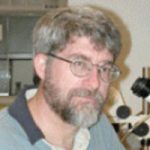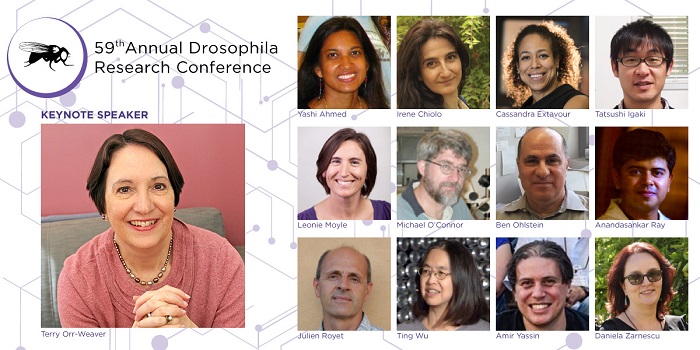Don’t miss out on this year’s Annual Drosophila Research Conference; check out the fantastic lineup of invited speakers below!
The conference will be held April 11–15, 2018 at the Philadelphia Marriott Downtown, covering a diversity of topics, from genetics, to molecular biology, cell biology, development, immunology, physiology, neuroscience, evolution, and more.
As well as the scientific programs, there will be a full lineup of community and professional development events. You can register at the advanced registration prices online until April 2. You will still be able to register online after April 5, but at the on-site registration rate. Students and postdocs interested in a particular topic or session can take advantage of day passes.
We’ll see you very soon!
Keynote Speaker:
Terry Orr-Weaver
Whitehead Institute, Dept. of Biology, MIT
Research taking flight from foundational biology
 In Drosophila, there is a wealth of fascinating biological processes whose regulation and mechanisms can be deciphered, building from a groundwork of powerful tools developed by the Drosophila community for multidisciplinary approaches. This biology and community provide an excellent training environment for PhD students and career opportunities for postdocs. Examples will be provided of choices of problems and approaches to gain fundamental insights into the control of meiosis, the oocyte-to-embryo transition, and DNA replication.
In Drosophila, there is a wealth of fascinating biological processes whose regulation and mechanisms can be deciphered, building from a groundwork of powerful tools developed by the Drosophila community for multidisciplinary approaches. This biology and community provide an excellent training environment for PhD students and career opportunities for postdocs. Examples will be provided of choices of problems and approaches to gain fundamental insights into the control of meiosis, the oocyte-to-embryo transition, and DNA replication.
Invited Speakers:
Yashi Ahmed
Dept. Molecular and Systems Biology, Dartmouth Med School, Hanover, NH
The guts of Wnt signal transduction
 Ahmed uses a Drosophila model to study core principles that underlie Wnt/Wingless pathway activation. She is testing the long-held tenet that Wingless function requires spread from its site of synthesis to form a gradient that specifies distinct cell fates as a function of ligand concentration. This view was recently upended by the unexpected finding that tethering of Wingless to the membrane produces adults with nearly normal external morphology, indicating that the spreading of Wingless is largely dispensable for tissue patterning. To confirm that Wingless spreading is also unnecessary for the patterning of internal organs, Ahmed is studying the adult gut, in which Wingless gradients are established during development and persist through adulthood.
Ahmed uses a Drosophila model to study core principles that underlie Wnt/Wingless pathway activation. She is testing the long-held tenet that Wingless function requires spread from its site of synthesis to form a gradient that specifies distinct cell fates as a function of ligand concentration. This view was recently upended by the unexpected finding that tethering of Wingless to the membrane produces adults with nearly normal external morphology, indicating that the spreading of Wingless is largely dispensable for tissue patterning. To confirm that Wingless spreading is also unnecessary for the patterning of internal organs, Ahmed is studying the adult gut, in which Wingless gradients are established during development and persist through adulthood.
Irene Chiolo
Molecular and Computational Biology Department, University of Southern California, Los Angeles, CA
Highways for repair: nuclear actin filaments and myosins relocalize heterochromatic DNA breaks to the nuclear periphery
 In Drosophila cells, ‘safe’ homologous recombination repair of heterochromatic double-strand breaks (DSBs) relies on a specialized pathway that relocalizes repair sites to the nuclear periphery. Chiolo and colleagues discovered that this relocalization depends on Arp2/3-dependent dynamic actin filaments. Relocalization also requires nuclear myosins and the myosin activator Unc45, which is recruited to repair sites in a Smc5/6-dependent manner. These same components are also required to relocalize heterochromatin DSBs in mouse cells. Defects in nuclear actin polymerization and myosin motor function result in heterochromatin repair defects and widespread chromosome rearrangements, revealing the importance of the relocalization pathway in genome integrity.
In Drosophila cells, ‘safe’ homologous recombination repair of heterochromatic double-strand breaks (DSBs) relies on a specialized pathway that relocalizes repair sites to the nuclear periphery. Chiolo and colleagues discovered that this relocalization depends on Arp2/3-dependent dynamic actin filaments. Relocalization also requires nuclear myosins and the myosin activator Unc45, which is recruited to repair sites in a Smc5/6-dependent manner. These same components are also required to relocalize heterochromatin DSBs in mouse cells. Defects in nuclear actin polymerization and myosin motor function result in heterochromatin repair defects and widespread chromosome rearrangements, revealing the importance of the relocalization pathway in genome integrity.
Cassandra Extavour
Department of Organismic and Evolutionary Biology, Harvard University, Cambridge MA
Reproductive Capacity Evolves in Response to Ecology through Common Developmental Mechanisms
 In Drosophila, reproductive capacity in females is determined by the number of ovarioles, the egg-producing subunits of the ovary. Ovariole number is largely heritable, but also displays some phenotypic plasticity under different environmental conditions, including nutritional input. In the Hawaiian Drosophila, ovariole number can range from 1 to over 100 ovarioles per ovary. Extavour and colleagues report insights into the developmental mechanisms regulating ovariole number and its evolution among Hawaiian Drosophila. They show that there is a trade-off between ovariole number and egg size, that reductions in ovariole number evolve alongside shifts to specific food sources, and that ovariole number variation among species with different food sources is best explained by adaptation to specific ecological niches.
In Drosophila, reproductive capacity in females is determined by the number of ovarioles, the egg-producing subunits of the ovary. Ovariole number is largely heritable, but also displays some phenotypic plasticity under different environmental conditions, including nutritional input. In the Hawaiian Drosophila, ovariole number can range from 1 to over 100 ovarioles per ovary. Extavour and colleagues report insights into the developmental mechanisms regulating ovariole number and its evolution among Hawaiian Drosophila. They show that there is a trade-off between ovariole number and egg size, that reductions in ovariole number evolve alongside shifts to specific food sources, and that ovariole number variation among species with different food sources is best explained by adaptation to specific ecological niches.
Tatsushi Igaki
Graduate School of Biostudies, Kyoto University, Kyoto, Japan
Mechanisms and roles of tumor-suppressive cell competition
 Normal epithelial cells often exert anti-tumor effects against nearby oncogenic cells. In Drosophila imaginal epithelia, clones of oncogenic cells mutant for apico-basal polarity genes are actively eliminated when surrounded by wild-type cells. It has been shown that JNK signaling plays a crucial role in this elimination; however, the initial event occurring at the interface between normal cells and polarity-deficient cells remained unknown. Through a genetic screen in Drosophila, Igaki identified the ligand Sas and the receptor-type tyrosine phosphatase PTP10D as the cell-surface ligand-receptor system that drives tumor-suppressive cell competition. These findings uncover the mechanism by which normal epithelial cells recognize and eliminate oncogenic neighbors by cell competition.
Normal epithelial cells often exert anti-tumor effects against nearby oncogenic cells. In Drosophila imaginal epithelia, clones of oncogenic cells mutant for apico-basal polarity genes are actively eliminated when surrounded by wild-type cells. It has been shown that JNK signaling plays a crucial role in this elimination; however, the initial event occurring at the interface between normal cells and polarity-deficient cells remained unknown. Through a genetic screen in Drosophila, Igaki identified the ligand Sas and the receptor-type tyrosine phosphatase PTP10D as the cell-surface ligand-receptor system that drives tumor-suppressive cell competition. These findings uncover the mechanism by which normal epithelial cells recognize and eliminate oncogenic neighbors by cell competition.
Leonie Moyle
Biology, Indiana University, Bloomington, IN
Sexual interactions and the evolution of species isolating barriers
 Sexual selection is frequently proposed as a powerful driver of speciation, but how it does so remains controversial. Focusing on postcopulatory reproductive traits in flies, Moyle and colleagues have been evaluating the role of sexually selected traits in the expression of isolating barriers. They found positive phenotypic and genetic associations between male sexual performance within and between species, two necessary conditions for sexual selection to drive speciation. This data indicates that sexually selected postcopulatory traits, such as sperm precedence, can both enhance reproductive isolation between species and respond to selection on reproductive isolation.
Sexual selection is frequently proposed as a powerful driver of speciation, but how it does so remains controversial. Focusing on postcopulatory reproductive traits in flies, Moyle and colleagues have been evaluating the role of sexually selected traits in the expression of isolating barriers. They found positive phenotypic and genetic associations between male sexual performance within and between species, two necessary conditions for sexual selection to drive speciation. This data indicates that sexually selected postcopulatory traits, such as sperm precedence, can both enhance reproductive isolation between species and respond to selection on reproductive isolation.
Michael O’Connor
Gen, Cell Biol, Dev, Univ Minnesota, Minneapolis, MN
Non-conventional autophagy in the prothoracic gland mediates a larval nutritional checkpoint through alteration of cholesterol trafficking.
 Drosophila larvae will not pass through certain developmental checkpoints if nutritional requirements are not met. The molecular mechanism responsible for inducing developmental arrest prior to satisfying these requirements is not understood. O’connor and colleagues demonstrate that starvation strongly induces an autophagy-like process within the prothoracic gland prior to achieving developmental checkpoints. This process is one mechanism by which checkpoints delay development if sufficient energy reserves have not been sequestered to ensure successful maturation of the juvenile larva into the adult fly.
Drosophila larvae will not pass through certain developmental checkpoints if nutritional requirements are not met. The molecular mechanism responsible for inducing developmental arrest prior to satisfying these requirements is not understood. O’connor and colleagues demonstrate that starvation strongly induces an autophagy-like process within the prothoracic gland prior to achieving developmental checkpoints. This process is one mechanism by which checkpoints delay development if sufficient energy reserves have not been sequestered to ensure successful maturation of the juvenile larva into the adult fly.
Ben Ohlstein
Dept Genetics & Development, Columbia Univ, New York, NY
Regulation of stem cell number in the intestine
 Because the intestine relies on the function of resident intestinal stem cells (ISCs) for survival, its homeostasis is intimately linked to stem cell number. Stem cell replacement is thought to be driven by symmetric division of existing stem cells; however, alternate mechanisms to symmetric divisions are largely unexplored. To probe alternative modes of ISC replacement, Ohlstein and colleagues developed a physiologically-relevant starvation assay that elicits a rapid and severe loss of ISCs in the Drosophila posterior midgut. Using this assay, they demonstrate that, in areas nearly void of progenitor cells, ISCs are rapidly replaced upon re-feeding by depolyploidization of enterocytes through the process of amitosis.
Because the intestine relies on the function of resident intestinal stem cells (ISCs) for survival, its homeostasis is intimately linked to stem cell number. Stem cell replacement is thought to be driven by symmetric division of existing stem cells; however, alternate mechanisms to symmetric divisions are largely unexplored. To probe alternative modes of ISC replacement, Ohlstein and colleagues developed a physiologically-relevant starvation assay that elicits a rapid and severe loss of ISCs in the Drosophila posterior midgut. Using this assay, they demonstrate that, in areas nearly void of progenitor cells, ISCs are rapidly replaced upon re-feeding by depolyploidization of enterocytes through the process of amitosis.
Anandasankar Ray
Molecular Cell & Systems Biology, Univ California, Riverside, Riverside, CA
Mechanisms of Odor-coding and its Manipulation to alter Behavior
 There are numerous mysteries about how the sense of smell guides behaviors like finding food, avoiding predators, and mating. Ray uses Drosophila as a model to understand molecular and cellular coding principles underlying olfactory behavior. He has found that different receptors and neurons contribute to different types of olfactory behaviors, which are further modified with experience. He has also uncovered a parallel non-receptor pathway that detects odorants that can be absorbed through the membrane into a cell. This pathway is slow-acting, more ancient than transmembrane receptors, and is highly conserved across eukaryotes.
There are numerous mysteries about how the sense of smell guides behaviors like finding food, avoiding predators, and mating. Ray uses Drosophila as a model to understand molecular and cellular coding principles underlying olfactory behavior. He has found that different receptors and neurons contribute to different types of olfactory behaviors, which are further modified with experience. He has also uncovered a parallel non-receptor pathway that detects odorants that can be absorbed through the membrane into a cell. This pathway is slow-acting, more ancient than transmembrane receptors, and is highly conserved across eukaryotes.
Julien Royet
IBDM, Aix Marseille University, Marseille, FR
Effects of the gut microbiota on host behavior and homeostasis
 Many reports have shown that bacteria can interact with the eukaryote nervous system, either for the benefit of the microbe or the benefit of the host. However, in most cases, the molecules and mechanisms underlying the dialog between bacteria and their host nervous system are poorly understood. Royet will present his latest data dissecting the cellular and molecular mechanisms by which one single microbiota-derived compound, peptidoglycan, influences the behavior, the physiology, and the homeostasis of its infected host.
Many reports have shown that bacteria can interact with the eukaryote nervous system, either for the benefit of the microbe or the benefit of the host. However, in most cases, the molecules and mechanisms underlying the dialog between bacteria and their host nervous system are poorly understood. Royet will present his latest data dissecting the cellular and molecular mechanisms by which one single microbiota-derived compound, peptidoglycan, influences the behavior, the physiology, and the homeostasis of its infected host.
Ting Wu
Harvard Med Sch, Boston, MA
Looking at chromosomes
 Wu will discuss two aspects of her studies of genome organization. One involves the application of haplotype resolved Hi-C to explore the structure of homolog pairing in Drosophila. The other has led to the development of two single-molecule super-resolution imaging technologies, OligoSTORM and OligoDNA-PAINT. Wu will also touch on their exploration of sequence ultraconservation and its potential relevance to homolog pairing.
Wu will discuss two aspects of her studies of genome organization. One involves the application of haplotype resolved Hi-C to explore the structure of homolog pairing in Drosophila. The other has led to the development of two single-molecule super-resolution imaging technologies, OligoSTORM and OligoDNA-PAINT. Wu will also touch on their exploration of sequence ultraconservation and its potential relevance to homolog pairing.
Amir Yassin
Institute of Systematics, Evolution and Biodiversity, CNRS – MNHN, Paris, FR
The genomic basis of adaptation in Drosophila: sex, poison and other dramas
 The great diversity of drosophilid flies offers a unique opportunity to genetically dissect ecologically relevant traits. Yassin will focus on two traits that have recurrently evolved in multiple Drosophila species: In D. erecta and more than 20 species of the montium group, females have a contrasting color dimorphism with one morph potentially mimicking males. In D. sechellia and a subspecies of D. yakuba inhabiting different oceanic islands, flies are strictly associated with the toxic fruits of the host plant, Morinda citrifolia. In both cases, a combination of population genomics, genome mapping, and functional analyses identified recurrent and idiosyncratic genetic changes underlying the evolution of convergent phenotypes. These findings provide new insights on the genetic mechanisms underlying the evolution of adaptive traits.
The great diversity of drosophilid flies offers a unique opportunity to genetically dissect ecologically relevant traits. Yassin will focus on two traits that have recurrently evolved in multiple Drosophila species: In D. erecta and more than 20 species of the montium group, females have a contrasting color dimorphism with one morph potentially mimicking males. In D. sechellia and a subspecies of D. yakuba inhabiting different oceanic islands, flies are strictly associated with the toxic fruits of the host plant, Morinda citrifolia. In both cases, a combination of population genomics, genome mapping, and functional analyses identified recurrent and idiosyncratic genetic changes underlying the evolution of convergent phenotypes. These findings provide new insights on the genetic mechanisms underlying the evolution of adaptive traits.
Daniela Zarnescu
Dept Molec & Cell Biol, Univ Arizona, Tucson, AZ
Lost in translation – RNA processing defects impact synaptic metabolism in neurodegeneration
 Amyotrophic lateral sclerosis (ALS) is a fatal neurodegenerative disease characterized by motor neuron death and muscle atrophy, and the RNA binding protein TDP-43 has emerged as a major molecular factor in this disease. Zarnescu has uncovered TDP-43-dependent synaptic deficits caused by mRNA sequestration and translation inhibition in fly- and patient-derived motor neurons. Transcriptome and translatome profiling show that synaptic and metabolic genes are dysregulated in degenerating motor neurons. These findings indicate that RNA-based mechanisms can explain key functional deficits in motor neuron disease and inform therapeutic strategies.
Amyotrophic lateral sclerosis (ALS) is a fatal neurodegenerative disease characterized by motor neuron death and muscle atrophy, and the RNA binding protein TDP-43 has emerged as a major molecular factor in this disease. Zarnescu has uncovered TDP-43-dependent synaptic deficits caused by mRNA sequestration and translation inhibition in fly- and patient-derived motor neurons. Transcriptome and translatome profiling show that synaptic and metabolic genes are dysregulated in degenerating motor neurons. These findings indicate that RNA-based mechanisms can explain key functional deficits in motor neuron disease and inform therapeutic strategies.































